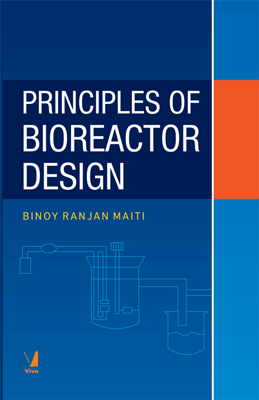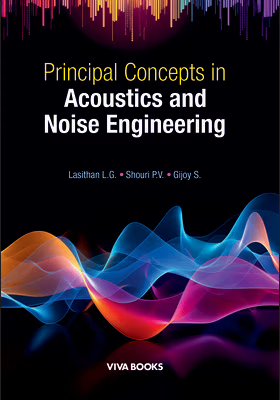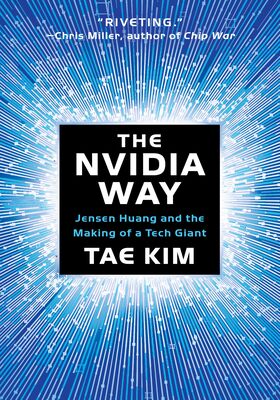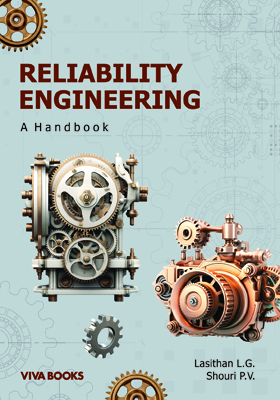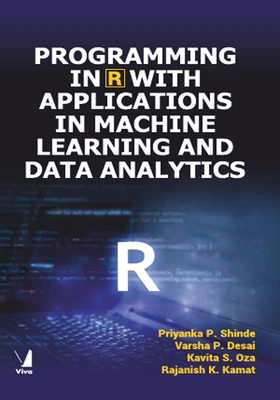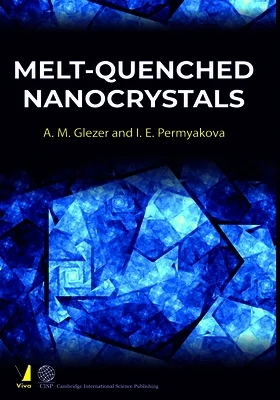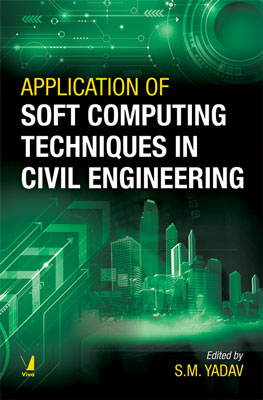Principles of Bioreactor Design
Principles of Bioreactor Design
₹1,435.50 ₹1,595.00 Save: ₹159.50 (10%)
Go to cartISBN: 9789387925076
Bind: Hardbound
Year: 2018
Pages: 606
Size: 172 x 242 mm
Publisher: Viva Books Originals
Sales Territory: Worldwide
Description:
Chemical products such as enzymes, antibiotics, solvents, proteins, antibodies, vaccines, hormones, interferons, etc. are in great demand as commercial commodities. There is an emerging trend towards utilizing biochemical processes for creating these products. These processes are characterized by their low energy requirement, the specificity of the chemicals produced and their mild environmental conditions.
All chemical and biochemical processes require a reaction vessel, a reactor, along with other downstream processing equipment. The reactor is recognized as the heart of any reaction process — its efficiency determines the economic feasibility of the process. Designing an efficient reactor requires the knowledge of appropriate kinetics, favourable hydrodynamic conditions and suitable mass and heat transfer.
The book deals with some basic aspects of reactor design for both chemical and biochemical systems. The first three chapters introduce the kinetics of chemical reaction engineering, the mechanistic model of catalytic gas-solid reactions and the residence time distribution for non-ideal reactors. These concepts are extended to biochemical reactor design. Characteristic features of enzyme kinetics both in free and immobilized state and microbial rate processes are covered in successive chapters. Advanced topics such as reactor dynamics, transport phenomena and membrane bioreactors have been incorporated wherever appropriate. The theoretical explanation is supported by solved and unsolved numerical problems.
Target Audience:
This book is useful for students and academicians of Biomedical Engineering, Zoology, Biotechnology, Chemical Engineering, Biochemistry, Biomaterials, Biomechanical Engineering.
Contents:
Preface
Chapter 1: Chemical Kinetics and Reactor Design • Introduction • Constant Volume Batch Reactor • Analysis of Batch Reactor Data by Integral and Differential Method • Integral method • Differential method • Zero order and negative order reaction • Complex reactions • Half - life time • Autocatalytic Reactions • Series Reactions with First Order Kinetics • Variable Volume Batch Reactor • Zero order reaction • First order reaction • Effect of Temperature on Specific Rate: Arrhenius Equation • Significance of activation energy • Chemical or Biochemical Reactors • Multiphase reactors • Mass balance in a flow reactor (plug flow reactor) • Continuous Stirred Tank Reactor (CSTR) • Fed Batch (Semibatch) Reactor • Plug Flow Reactor with Recycle • Kinetics of Non-elementary Reactions • Mechanisms of the decomposition of N2O5 • Non chain reactions • CSTRs in Series • Graphical method for tanks in series system • Combination of PFTR and CSTR in Series • Summary • References
Chapter 2: Gas-Solid Catalytic Reactions • Introduction • Adsorption Rates and Equilibrium • Chemisorption and Physical Adsorption • Adsorption Isotherms • BET equation • Freundlich adsorption isotherm • Langmuir adsorption isotherm • Development of Rate Equations Based on Langmuir Adsorption Isotherm or Hougen — Watson Models • Surface-reaction-rate controlling • Adsorption rate controlling • Rate Equations Based on Freundlich Adsorption Isotherm • Determination of Kinetic Parameters for Catalytic Reactions • Least square method / Linear regression • Initial rates • Determination of Some Engineering Properties of Solid Catalysts • External surface area • Internal (porous) surface area by BET method • Void volume and solid density • Pore size and pore size distribution • Effect of External Transport in Solid Catalyst • External diffusion and heat transfer • Heat transfer effect in the reaction of nonporous catalysts • Effect of Internal Transport in Porous Solid Catalysts • Determination of effective diffusivity, De • Effective thermal conductivity, ke • Diffusion and Reaction in Porous Catalyst Pellets • Effectiveness factor • Effectiveness factor for cylindrical pellet (?c) • Effectiveness factor for a flat plat (?L) • Prediction of intrapellet diffusion • Effect of intrapellet diffusion on the kinetics • Mass and Heat Transfer with Chemical Reaction within the Porous Catalyst Pellet • Non-isothermal effectiveness factor • Summary and Comments • References
Chapter 3: Residence Time Distribution, RTD • Introduction • Experimental Method for Determining E • Conversion from RTD in Flow Reactors (Segregated Model) • Dirac delta function, d(t-to) • Non-ideal Reactor Models • Dispersion model • Large deviation from plug flow when D/uL > 0.01 • Correlation for axial dispersion • Chemical reaction and dispersion in a tubular flow reactor • Tanks in Series Model • Two Parameters Models • Real CSTR with by-passing and dead space • RTD in a Tubular Reactor with Laminar Flow (Krammers et al 1963) • Conversion in laminar flow reaction • Summary • References
Chapter 4: Enzymatic Reactions and Bioreactor Design • Enzymes, their Classification and Applications • Enzyme Kinetics • Evaluation of Kinetic Parameters of M-M Equation • Significance of the Parameters kM and vmax • Kinetics for Allosteric Enzymes • Kinetics of Inhibited Enzyme Reactions • Enzyme Reactors with Michaelis-Menten Kinetics • A batch and a steady state plug flow reactor • Plug flow reactor for enzymatic reactions • Continuous stirred tank reactor with free enzymes • Kinetics for reversible reactions, two-substrate reactions, reaction with a co-factor (complex) • Kinetics of multiple substrates on a single enzyme • Effects of pH and Temperature on Enzyme Kinetics • Enzyme Deactivation • Simplest deactivation model and the enzyme kinetics • Effect of Shear, Surface Tension • Enzyme Kinetics for Insoluble Substrate • Kinetic model • Enzyme kinetics of cellulose degradation • Summary • References
Chapter 5: Kinetics of Immobilized Enzymes and Reactor Design • Introduction • Immobilization Techniques • Advantages of immobilized enymes or cells • External Diffusion on the Nonporous Surface Immobilized Enzymes • Internal Diffusion for Enzymes Immobilized in Porous Solids • Effectiveness factor for a porous spherical pellet with miechalis-menten kinetics • Effectiveness factor in terms of • & ?? • Effectiveness factor with zero-order kinetics • Effectiveness factor for first order reaction in a flat slab • Limitations of Enzymatic Reactions in Porous Solids • Effectiveness Factor for Simultaneous Film and Interparticle Mass Transfer • Effectiveness Factor for Cylindrical Particles with Immobilized Enzymes • Reactor Design for Immobilized Enzyme Systems • CSTR for immobilized enzymes • Packed bed enzymatic reactor • Deactivation of Immobilized Enzyme Catalyst in a Packed Bed Reactor • Summary • References
Chapter 6: Cell Kinetics and Reactor Design • Introduction • Cell Growth Kinetics • Batch Growth Patterns • Yield Coefficients • Cellular Product Formation Kinetics • Environmental Conditions for Cell Mass Growth and Product Formation • Monod Growth Kinetics (Unstructured Model) • Other Forms of Cell Growth Kinetics • Growth Model of Filamentous Organisms • Continuous Stirred Tank Fermenters • Turbidostat • Ideal chemostat • Commercial chemostat (stirred tank fermentor) • Batch Reactor • Plug Flow Fermenter (Tower Fermenter) • Batch Reactor and Chemostat • Non-ideal CSTR Model • Multiple Fermenters Operated in Series • A chemostat and PFR in series • Chemostats in series • Chemostat with a recycle • Fed-Batch Bioreactor • Repeated fed-batch culture • Perfusion Systems in a CSTR • References
Chapter 7: Transport Phenomena in Bioreactors • Outline • Gas-Liquid Mass Transfer in Microbial Cells • Basic mass transfer • Metabolic oxygen uptake • Measurement of kLa? • Gas — Liquid — Solid Reactors • Momentum and heat transfer (Continuous Stirred Tank Reactor [CSTR]) • Bubble columns • Air lift fermenters • Trickling biological filter • Relative merits and demerits of three basic bioreactors • Estimation of Overall Mass Transfer Coefficient, kLa • Power requirements for sparged and agitated vessels • Mass Transfer for Freely Rising or Falling Bodies • Mass transfer coefficient, kL for single bubbles and bubble swarms • Mechanisms of mass transfer • Determination of interfacial area • Photographic technique • Correlation for a and D32 • Determination of gas hold up, H • Power consumption in stirred reactors from dimensional analysis • Maximum stable bubble size • Theory of turbulence by kolmogorov • Problem on Turbulent Shear Damage in Animal Cell Culture • Forced Convective Mass Transfer • Mass transfer for turbulent flow correlation • Mass Transfer Across Liquid Surfaces • Rheology: Newtonian and Non Newtonian Fluids • Non-newtonian fluids • Power law model of oswald • de- Waele • Time dependent viscosity • Kinematic viscosity • Viscosity measurement • Impeller viscometer • Viscosity of suspensions • Viscosity of solutions containing macromolecules • Heat Transfer • Heat transfer correlations • Heat transfer in stirred liquids • Scale-up • Scale-up methods • Design of Bubble Column Reactor • Plug flow model for bubble column • Decker's dispersion model for bubble column • Design of Air-Lift Fermenters • References
Chapter 8: Sterilization Reactors • Introduction • Thermal Death Kinetics • Design Criterion, Del • Batch Sterilization • Continuous Sterilization • Holding section: plug flow model • Dispersion model for sterilization • Sterilization model based on residence time distribution • Microbial Death Kinetics: Deterministic and Statistical Approach • Statistical model • Other Types of Death Kinetics • References
Chapter 9: Design and Analysis of Bioreactors • Introduction • Ideal Plug Flow Tubular Reactor (PFTR) • Reactor Dynamics • Linearization of a set of non-linear differential equations • Stability analysis in terms of eigen values • Dynamics of monod chemostat model • Non-ideal Bioreactors in Terms of Residence Time Distribution • Tracer experiments • Non-ideal reactor models • Tanks-in-series model • Dispersion model • Axial dispersion, DL • Some Reactor Design Models • Packed bed reactor • Fluidized bed bioreactor • Trickle bed reactors • Air lift fermenter with external loop • CSTR for Immobilized Cells or Enzymes • Summary • References
Chapter 10: Reactors for Animal Cells, Recombinant Proteins and Plant Cells • Characteristic Features of Animal Cells • Growth in Animal Cell Culture • Environmental Conditions and Kinetics • Bioreactors for Animal Cell Culture • Roller bottles • Microcarriers • Modified CSTR • Hollow fiber bioreactor (HFBR) • Fixed bed or fluidized bed reactor • Microencapsulation • Reactors for Recombinant Proteins • Recombinant DNA technology • Genetic instability • Fermentation kinetics of the recombinant cells (in a batch reactor) • Stirred-tank fermenter for recombinant cells • Dynamics of plasmid containing cells • Plant Cells and Recombinant Plant Cells • Plant cell culture • Plant cell culture methodology • Bioreactors for plant cells culture • Reactors for suspension culture • Reactors for immobilized plant cells • Bioreactors for organized tissues • Genetic engineering of plant cells • Kinetics of plant cell growth • References
Chapter 11: Membrane Bioreactors • Introduction • Classification and Applications • Tubular Membrane Reactor • Shell-and-Tube Membrane Reactor • Hollow Fiber Biochemical Reactor (HFBR) • Mathematical modeling • Model equations and solutions • Overall mass transfer coefficient s • Model of hollow fiber biochemical reactor by waterland et al (1974) • Hollow fiber biochemical reactor for animal cell culture • Merits and demerits of HFRBs • Artificial kidney • Hemodialysis • Hemofiltration • Mathematical model for dialysis • Design of artificial kidney • Bioartificial Lever Device • References
Chapter 12: Biological Reactors for Waste Water Treatment • Introduction • Waste Water Treatment Methods • Characteristics of Waste Water • Biological Waste Treatment Reactors • The activated sludge process (CSTR with sludge recycle) • Reactor design and modeling of activated sludge process • Structured model for activated sludge process • Bioreactor for nitrification for tertiary treatment of waste water • Design equations for simultaneous BOD and NO3 removal • Trickling biological filter (TBR) • Bioreactors for anaerobic digestion • Model of graef and andrews (1976) for anaerobic digestion • Two-tank anaerobic digester model • Bioscrubbers • Model based on mass transfer and microbial reaction • Biofilters for treatment of waste gases • Rotating Biological Contactor (RBC) • Modeling of a rotating biological contactor • Aerated Lagoons or Basins (Oxidation Bond) • Modeling of aerated lagoon • Summary • References
Chapter 13: Miscellaneous Bioreactors • General Classification of Bioreactors • Algae Bioreactor • Auxostat • Photobioreactors • Turbidostat • Biostat • Ultraviolet Sterilizing Bioreactor • Anaerobic Membrane Bioreactor • References • Bioelectrochemical Reactors • Moss Bioreactors • References • Oscillatory Baffled Reactor • Single-use Bioreactor • Algae Fuel • Algae PARC • Research Projects on Algae Fermentation • Mathematical Modelling of Algae Fermentation
Appendices
Appendix 1: Multiple choice question (MCQ), Gate 2016?2006
Appendix 2: Short question, Gate 2016 ? Gate 2002
Appendix 3: Parameters, dimensions and SI units
Appendix 4: CGS and SI prefixes, values of gas constants
Appendix 5: Michaelis constants for some enzyme and substrate systems
Appendix 6: Effective diffusivities of solutes in biological gels in aqueous solution
Appendix 7: Respiration rates of microorganisms, plant and animal cells
Appendix 8: Dimensionless groups
Appendix 9: Henry's constants for gases sparingly soluble in water at 298 K; Solubility of some gases
Appendix 10: Some primary metabolites of industrial importance
Appendix 11: Some mathematical formulae
List of Symbols
Index
About the Author:
Binoy Ranjan Maiti obtained his B.Tech in Chemical Engineering from Calcutta University and his M.Tech and Ph.D. in Chemical Engineering from IIT Kharagpur. He was a faculty member in the Department of Chemical Engineering from 1968 to 2002, becoming a professor in 1985, and a post-doctoral fellow in the University of Ghent, Belgium from 1975 to 1977. He was a professor emeritus in the Department of Biotechnology at the Heritage Institute of Biotechnology, Kolkata, from 2002 to 201 2. His fields of interest include Reaction Engineering Kinetics, Chemical Engineering, Thermodynamics, Biochemical Engineering and pollution control, among others. He has published 65 technical papers in various national and international journals.
